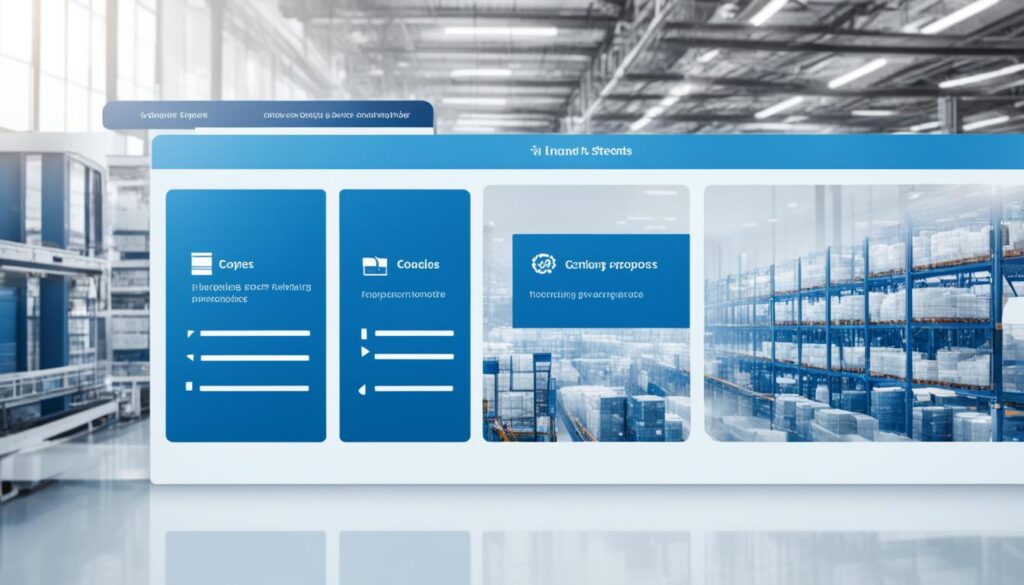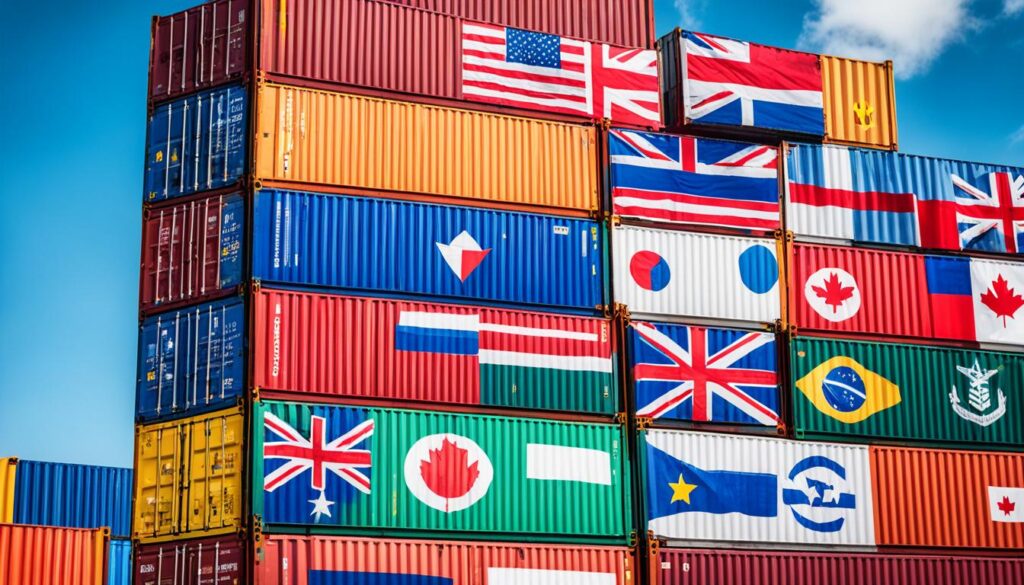In today’s interconnected global economy, cross-border transactions play a vital role in international commerce and the expansion of businesses worldwide. As businesses seek opportunities beyond their borders, it becomes essential to understand the intricacies of cross-border payments and how to navigate the challenges they present.
Are you ready to explore the world of cross-border transactions and discover strategies for mastering global payments? Join me as we unravel the complexities of overseas transactions, foreign exchange transactions, and cross-border financial transactions. Together, we will uncover the secrets to optimizing cross-border money transfers and unleashing the full potential of your business in the international market.
Key Takeaways:
- Cross-border transactions are integral to international commerce and business expansion.
- Understanding the complexities of cross-border payments is crucial for businesses seeking global growth.
- Optimizing cross-border money transfers can unlock opportunities and maximize the efficiency of global trade transactions.
- Exploring strategies and partnering with trusted payment service providers can enhance cross-border financial transactions.
- The future of cross-border transactions lies in technological advancements, regulatory collaboration, and meeting evolving customer expectations.
The Importance of Cross-Border Payments in International Trade
Cross-border payments play a vital role in international trade, enabling businesses to engage in import-export transactions and expand their global reach. With the rise of e-commerce and the increasing demand for international products and services, businesses need efficient and reliable cross-border payment systems to facilitate smooth transactions.
Cross-border payments involve the transfer of money across national boundaries, allowing businesses to receive payment from international customers and pay suppliers in different countries. These transactions require different payment methods and currencies, making cross-border payments more complex than domestic transactions.
Businesses that can master cross-border payments gain a competitive advantage in global commerce. By ensuring seamless and secure financial flow, businesses can establish trust with international partners, optimize cash flow, and overcome the hurdles associated with cross-border transactions.
Whether it’s a small online retailer reaching customers overseas or a multinational corporation expanding its operations globally, cross-border payments are essential for facilitating international trade and driving economic growth.
“Cross-border payments are the lifeblood of international commerce. Without efficient payment systems, global trade and business expansion would be significantly hindered.”
The Challenges of Cross-Border Payments
While cross-border payments offer numerous opportunities, they also present unique challenges. Businesses must navigate complex regulatory environments, fluctuating exchange rates, and varying payment methods across different countries. These challenges can result in delays, higher transaction costs, and increased risk.
Overcoming Challenges with Innovative Solutions
To overcome these challenges, businesses need to adopt innovative solutions that streamline cross-border payments and ensure seamless international transactions. Fintech companies and payment service providers offer advanced technologies and services that simplify cross-border payments, including:
- Global payment platforms that support various currencies and payment methods
- Real-time exchange rate optimization to reduce costs
- Comprehensive compliance checks to ensure regulatory adherence
- Transparency in pricing and competitive transaction fees
By leveraging these solutions, businesses can enhance the efficiency, security, and cost-effectiveness of their cross-border payment processes.
The Future of Cross-Border Payments
The future of cross-border payments looks promising, with rapid advancements in technology and increasing collaboration among international regulators. Emerging technologies such as blockchain and digital currencies offer the potential to revolutionize cross-border transactions, making them faster, more secure, and less expensive.
Furthermore, collaborations among payment networks, fintech companies, and governments aim to establish standardized frameworks and regulations, simplifying cross-border payments and fostering global economic growth.
Table: Comparison of Major Cross-Border Payment Solutions
| Payment Solution | Advantages | Disadvantages |
|---|---|---|
| Fintech Platforms | – Global reach and support for multiple currencies – Technologically advanced solutions – Lower transaction fees |
– May require integration with existing systems – Ongoing maintenance and upgrade costs |
| Traditional Banks | – Established trust and reliability – Extensive global network |
– Higher transaction fees – Limited technological innovations |
| Emerging Technologies (Blockchain) | – Greater security and speed – Reduced costs through decentralized networks |
– Regulatory and scalability challenges – Limited mainstream adoption |
As technology continues to evolve and global commerce expands, cross-border payments will play an increasingly pivotal role in facilitating seamless international trade. Businesses that adapt to these advancements and embrace innovative payment solutions will be well-positioned to thrive in the global marketplace.

Understanding the Cross-Border Payment Process Flow
The cross-border payment process involves several steps and intermediaries. To initiate a payment, a customer uses their preferred payment method, such as a credit card, bank transfer, or local payment option. The payment request is then received and validated by the payment service provider (PSP) of the merchant. The PSP may perform currency conversion, fraud prevention, and compliance checks to ensure the transaction’s security and legality.
The payment instruction is then sent to the correspondent bank of the merchant’s country, which acts as an intermediary for cross-border payments. The correspondent bank transfers the funds to the respondent bank of the customer’s country, which delivers them to the final beneficiary. Depending on the countries, currencies, and payment methods involved, there may be additional steps and intermediaries in the cross-border payment process.
Each step can incur fees, delays, and risks. Businesses should be aware of the intricacies of the process to optimize their cross-border payment flows and minimize costs.

By comprehending the cross-border payment process flow, businesses can navigate the complexities more effectively and make informed decisions, ensuring secure and efficient international transactions.
Optimizing Cross-Border Payments: Best Practices and Solutions
To optimize cross-border payments, businesses can implement best practices and leverage technology-driven solutions. By doing so, they can reduce transaction costs, enhance security, and provide a seamless payment experience for their customers.
One effective method is partnering with a reputable payment service provider (PSP) that specializes in cross-border transactions. These PSPs offer solutions that streamline payment processes, reduce fees, and ensure secure transactions. By providing direct access to local payment networks, these providers bypass correspondent banks, minimizing unnecessary intermediaries and associated costs.
An important aspect of optimizing cross-border payments is leveraging technology. Real-time payment systems, for example, allow businesses to process transactions instantly, providing customers with immediate payment confirmation and improving cash flow. Additionally, PSPs that offer instant notifications keep businesses informed about successful or failed transactions, enabling prompt action.
Transparent pricing is crucial for cross-border payments. Businesses should work with PSPs that provide clear and upfront pricing information, ensuring transparency and helping them make informed decisions. This transparency helps businesses to accurately calculate transaction costs, plan budgets, and avoid any hidden fees or surprises.
Regulatory compliance is another key component when optimizing cross-border payments. Businesses should partner with PSPs that adhere to international regulations and comply with anti-money laundering (AML) and know your customer (KYC) requirements. Staying compliant not only mitigates risks but also helps build trust with customers and regulatory authorities.
By following these best practices and leveraging technology-driven solutions, businesses can streamline their cross-border payment processes, reduce transaction costs, and enhance security. This optimization allows them to provide a seamless payment experience for their customers, gain a competitive edge, and thrive in the global marketplace.
The Divergence of Visa and Mastercard in Cross-Border Payments
Visa and Mastercard, two prominent payment processors in the United States, have taken different approaches to cross-border payments. While both companies have achieved widespread acceptance and consistent growth in the global market, they are now focusing on enhancing their capabilities in specific areas. Mastercard has set its sights on the business-to-business (B2B) payments market and is investing in the development of fast automated clearing house (ACH) rails, which enable efficient B2B transactions. On the other hand, Visa is prioritizing its Visa Direct push payment rails to improve consumer and business-to-consumer transactions.
Mastercard’s emphasis on B2B payments aligns with the growing demand for streamlined financial processes between businesses operating in different countries. By investing in fast ACH rails, Mastercard aims to provide businesses with efficient cross-border payment solutions, enabling seamless transactions and facilitating international trade.
Visa, on the other hand, has recognized the importance of enhancing consumer and business-to-consumer transactions. Leveraging the Visa Direct push payment rails, Visa aims to improve the convenience, speed, and security associated with these types of transactions. This strategic focus allows Visa to cater to the evolving needs and expectations of consumers, who increasingly demand real-time payments and seamless cross-border transactions.
Both Visa and Mastercard understand the importance of technology-driven solutions in the cross-border payments landscape. They are continuously investing in technological advancements and forming strategic partnerships to expand their offerings and remain competitive in this rapidly evolving industry.

Cross-Border Fees in International Transactions
When engaging in international transactions, businesses need to be aware of the various fees involved. These fees can impact the cost of accepting international payments and should be considered when assessing the financial implications. The main types of fees associated with cross-border transactions include cross-border fees, assessment fees, foreign transaction fees, and currency exchange fees.
Cross-Border Fees
Cross-border fees are assessment fees charged by cardmember associations like Visa and Mastercard when customers use cards from international banks at businesses. They were introduced in 2005 to account for the costs and complexities involved in cross-border transactions. These fees are usually a percentage of the transaction amount and can vary based on the cardmember association and the currency in which the transaction is settled.
Assessment Fees
Assessment fees are fees charged by cardmember associations for providing access to their payment networks. These fees are determined by the associations and can differ based on factors such as transaction volume, card types, and geographical regions.
Foreign Transaction Fees
Foreign transaction fees encompass cross-border fees along with other international assessment fees. These fees are incurred when customers make transactions in foreign currencies. It’s important for businesses to understand the fees charged by the cardmember associations and consider them when pricing their products or services.
Currency Exchange Fees
Currency exchange fees are separate from cross-border fees and are associated with the conversion of currencies in international transactions. When businesses accept payments in a foreign currency, these fees may apply if the funds need to be converted to the merchant’s local currency. These fees can be a percentage of the transaction amount or a fixed fee, depending on the payment processor or financial institution involved.
By understanding the different types of fees involved in cross-border transactions, businesses can accurately assess the costs of accepting international payments. It’s essential to factor these fees into pricing strategies and consider options for mitigating them, such as partnering with payment service providers that offer competitive rates and transparent pricing.
Calculating Cross-Border Fees for International Transactions
When conducting international transactions, it is crucial for businesses to understand how cross-border fees are calculated. These fees are determined by two key factors: the currency of the transaction and the merchant’s country of domicile in relation to the card issuer’s country. Different cardmember associations have varying percentages for their assessment fees. Let’s take a closer look at some examples:
| Cardmember Association | Currency of Transaction | Percentage of Cross-Border Fee |
|---|---|---|
| Visa | USD | 1.00% |
| Visa | Other Currencies | 1.40% |
| Mastercard | USD | 0.60% |
| Mastercard | Other Currencies | 1.00% |
| Discover | Card Sales Conducted in the U.S. with Cards Issued Outside the U.S. | 0.80% |
Businesses should be aware of these fees and consider them when analyzing the costs associated with international transactions. By understanding the cross-border fee structure, businesses can make informed decisions and optimize their payment processes.

Strategies to Reduce Cross-Border Fees
While it is challenging to completely avoid cross-border fees, businesses can implement certain strategies to reduce their impact. By considering the specific needs of international markets and diversifying their operations, businesses can optimize their cross-border transactions and minimize fees.
1. Utilize Local Distributors
One effective approach to reducing cross-border fees is to partner with local distributors in international markets. By working with distributors who operate in the target country, businesses can conduct transactions in the local currency. This eliminates the need for currency conversion and reduces cross-border fees. Moreover, local distributors have a better understanding of the local market and can help businesses navigate any regulatory requirements or cultural differences.
2. Establish Separate Business Branches
Setting up separate business branches in international markets can also mitigate the impact of cross-border fees. By establishing a physical presence in the target country, businesses can operate locally and conduct transactions in the domestic currency. This effectively eliminates the need for cross-border payments and minimizes associated fees. Additionally, having local branches allows businesses to better serve international customers and build stronger relationships within the local market.
3. Partner with Local Banks
Partnering with local banks in target countries can help businesses reduce cross-border fees and facilitate direct currency transactions. Local banks have in-depth knowledge of the local banking system and can provide efficient payment solutions tailored to the specific needs of businesses. By leveraging the local banking infrastructure, businesses can avoid intermediary banks and streamline their cross-border payment processes, resulting in reduced fees and faster transaction times.
4. Optimize Direct Currency Transactions
Direct currency transactions can significantly minimize cross-border fees. By conducting transactions in the local currency, businesses can avoid unnecessary currency conversion costs and reduce cross-border fees. To optimize direct currency transactions, businesses should work with trusted payment service providers that offer competitive exchange rates and low transaction fees.
5. Leverage Technology-Driven Solutions
Advancements in technology have paved the way for innovative solutions that can help businesses reduce cross-border fees. By leveraging payment platforms that offer automated currency conversion and competitive rates, businesses can optimize their cross-border transactions. Additionally, utilizing digital payment solutions and real-time payment processing can enhance efficiency and minimize costs associated with traditional cross-border payments.
Implementing these strategies can empower businesses to reduce cross-border fees and optimize their international transactions. By considering the unique needs of international markets, partnering with local entities, and leveraging technology-driven solutions, businesses can navigate the complexities of cross-border transactions and unlock growth opportunities in the global market.

Partnering with a Trusted Cross-Border Payment Service Provider
When it comes to cross-border transactions, partnering with a trusted payment service provider can make all the difference. With the complexities involved in international payments, businesses need a reliable partner to navigate the intricacies and optimize their payment processes. That’s where a reputable provider like DNBC Financial Group comes in.
DNBC Financial Group offers secure and efficient cross-border payment solutions, ensuring that your transactions are conducted safely and smoothly. They prioritize the safety of your funds and adhere to regulatory standards, providing peace of mind and a secure environment for your transactions.
With DNBC Financial Group, you can also benefit from competitive exchange rates, which can save your business money when dealing with different currencies. Additionally, their low transaction fees help minimize costs and maximize your returns.
One of the key advantages of partnering with a trusted payment service provider like DNBC Financial Group is their global network. They have established connections and partnerships worldwide, allowing you to conduct cross-border transactions seamlessly and expand your reach in the international market.
Furthermore, DNBC Financial Group offers personalized solutions tailored to the unique requirements of your business. They understand that each business is different, with its own specific needs and preferences. By taking a personalized approach, they ensure that their payment services align with your business goals and objectives.
In summary, partnering with a trusted payment service provider like DNBC Financial Group can provide your business with the tools and support needed to master cross-border transactions. From secure and efficient payment solutions to competitive rates and a global network, they have you covered. Take advantage of their personalized approach and optimize your cross-border payment processes for success in the international market.
The Future of Cross-Border Payments
The future of cross-border payments is set to be shaped by several key factors, including technological advancements, regulatory collaboration, evolving customer expectations, and industry trends. These elements will drive the transformation of cross-border payment systems, making them more efficient, secure, and seamless.
Technological advancements are at the forefront of driving change in cross-border payments. Innovations such as blockchain, cloud computing, and artificial intelligence have the potential to revolutionize the way international transactions are conducted. These technologies will enable faster processing times, enhanced security measures, and improved transparency in cross-border payments.
Regulatory collaboration will play a crucial role in streamlining cross-border payments. Increased cooperation among regulators, payment providers, and international organizations will lead to the development of standardized frameworks and regulations, reducing complexity and ensuring a more consistent and secure cross-border payment ecosystem.
Customer expectations are constantly evolving, and this will shape the future of cross-border payments. Customers now expect seamless and transparent global payment experiences. Real-time payments and enhanced customer experiences will become commonplace as businesses strive to meet these expectations and provide frictionless payment solutions.
The industry trends in cross-border payments are also worth noting. The increasing popularity of e-commerce and the growth of global markets will continue to drive the demand for more efficient cross-border payment systems. Businesses will need to adapt to these trends and adopt innovative solutions to stay competitive in the global marketplace.
To summarize, the future of cross-border payments will be characterized by technological advancements, regulatory collaboration, evolving customer expectations, and industry trends. Businesses that embrace these changes and invest in modern payment solutions will be well-positioned to thrive in the evolving international payment landscape.
Conclusion
In conclusion, cross-border transactions play a crucial role in the ever-expanding realm of global commerce. By facilitating international trade and enabling businesses to reach new markets, cross-border payments have become an integral part of the modern business landscape. While the process of cross-border transactions can be complex and involve various fees, businesses can optimize their international transactions through a combination of understanding the payment process flow, implementing best practices, leveraging technology-driven solutions, and partnering with trusted payment service providers.
As the future of cross-border payments continues to evolve, it is essential for businesses to adapt to technological advancements, collaborate with regulators, and meet customer expectations in order to remain competitive in the global market. By mastering cross-border transactions, businesses have the opportunity to unlock growth potential and navigate the complexities of international commerce with confidence and efficiency.
Whether it is streamlining payment processes, reducing costs, or enhancing security, the optimization of cross-border transactions is a key factor in establishing a strong foothold in the global marketplace. By staying informed about industry trends, embracing innovative solutions, and making strategic partnerships, businesses can position themselves at the forefront of the global commerce landscape and succeed in their international endeavors.
FAQ
What are cross-border transactions?
Why are cross-border payments important in international trade?
How does the cross-border payment process flow work?
What are some best practices for optimizing cross-border payments?
What is the difference between Visa and Mastercard in cross-border payments?
How are cross-border fees calculated in international transactions?
How can businesses reduce cross-border fees?
Why is it important to partner with a trusted cross-border payment service provider?
What does the future hold for cross-border payments?
Source Links
- https://www.dnbcf.com/blog/master-cross-border-payments-best-practices-for-international-transactions
- https://www.spglobal.com/marketintelligence/en/news-insights/latest-news-headlines/visa-mastercard-bet-big-on-different-growth-strategies-56797573
- https://www.tidalcommerce.com/learn/cross-border-fee






